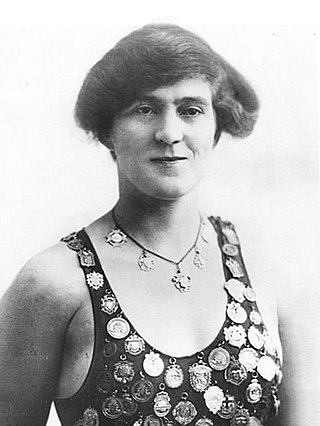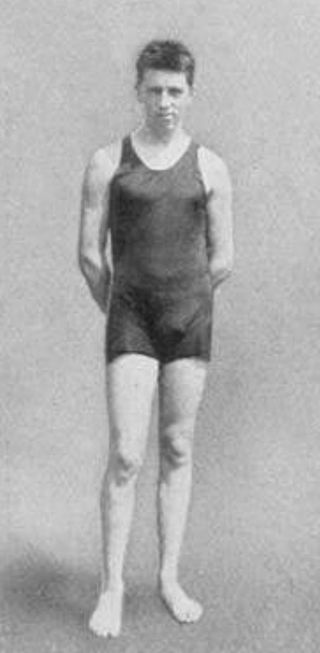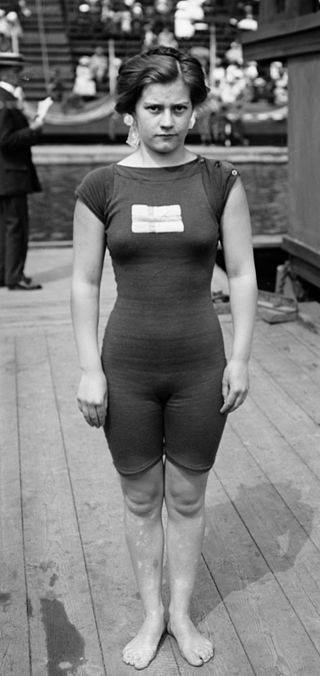
Dawn Fraser is an Australian freestyle champion swimmer, eight-time olympic medallist, a 15-year world record holder in the 100-metre freestyle, and former politician. Controversial, yet the winner of countless honours, she has enjoyed national prominence and sparked national pride in Australia. She is one of only four swimmers to have won the same Olympic individual event three times – in her case the women's 100-metre freestyle.

Thornaby-on-Tees, commonly referred to as Thornaby, is a town and civil parish in the North Yorkshire part of the borough of Stockton-on-Tees, England. The parish had a population of 24,741 at the 2011 census, in the Teesside built-up area. It is located on the south bank of the River Tees.

Michael Groß, usually spelled Michael Gross in English, is a former competitive swimmer from Germany. He is 201 centimetres tall, and received the nickname "The Albatross" for his especially long arms that gave him a total span of 2.13 meters. Gross, competing for West Germany, won three Olympic gold medals, two in 1984 and one in 1988 in the freestyle and butterfly events, in addition to two World Championship titles in 1982, two in 1986 and one in 1991.

James Paul Montgomery is an American former competition swimmer, four-time Olympic medalist, and former world record-holder. Montgomery was the first man to break the 50-second barrier (49.99) in the 100-meter freestyle, at the 1976 Summer Olympics in Montreal, Quebec, where he won three gold medals and one bronze.

Donald Arthur Schollander is an American former competition swimmer, five-time Olympic champion, and former world record-holder in four events. He won a total of five gold medals and one silver medal at the 1964 and 1968 Summer Olympics. With four gold medals, he was the most successful athlete at the 1964 Olympics.

Sarah Frances "Fanny" Durack, also known by her married name Fanny Gately, was an Australian competition swimmer. From 1910 until 1918 she was the world's greatest female swimmer across all distances from freestyle sprints to the mile marathon.
Ronald Brian Jacks was a Canadian Olympic and international swimmer in the 1960s and 1970s. He is currently a leading coach for Canadian swimmers such as Richard Weinberger through the Pacific Coast Swimming Club.

George Ritchie Hodgson was a Canadian competition swimmer of the early 20th century, and considered by many to be the greatest swimmer in Canadian history. Hodgson won the two longer freestyle swimming gold medals at the 1912 Olympics, the only categories in which he competed. He also competed at the 1920 Summer Olympics.

Sir Francis Joseph Edmund Beaurepaire was an Australian distance freestyle swimmer from the 1900s to the 1920s, who won three silver and three bronze medals, from the 1908 Summer Olympics in London to the 1924 Summer Olympics in Paris.

Harold Hampton Hardwick was a versatile Australian sports star of the early 20th century – an Olympic gold medal swimmer, national heavyweight boxing champion, and a state representative rugby union player. He later became a colonel in the Australian Imperial Force. Hardwick was on the winning team of the 4x200-metre freestyle relay at the 1912 Summer Olympics and won bronze medals in the 400-metre and 1500-metre freestyle.

Andrew Murray "Boy" Charlton was an Australian freestyle swimmer of the 1920s and 1930s who won a gold medal in the 1500 m freestyle at the 1924 Summer Olympics in Paris. He set five world records and also won a further three silver and one bronze medal in his Olympic career.

Mary Alice Bradburne is an American former competition swimmer, two-time Olympic gold medalist, and television sports commentator. During her international swimming career, Wayte won ten medals in major international championships, including four golds.

Henry Taylor was an English competitive swimmer who represented Great Britain in four Summer Olympics between 1906 and 1920. Taylor served in the Royal Navy during the First World War, and continued to swim competitively until 1926. His fortunes declined after he retired and he died penniless. His record of three gold medals at one Olympic Games – the most by any Briton – stood for 100 years until it was equaled by cyclist Chris Hoy in 2008. Tying the medal count of American Mel Sheppard, he was the most successful athlete at the 1908 Olympics.

Stephen Edward Clark is an American former competition swimmer for Yale University, Olympic champion, and former world record-holder.

Perry McGillivray was an American competition swimmer and water polo player who represented the United States at the 1912 Summer Olympics and 1920 Summer Olympics.

Anna Teresa Margareta "Greta" Johansson was a Swedish diver and swimmer, who competed at the 1912 Summer Olympics. She won the gold medal in the 10 m platform and finished fourth with the Swedish 4 × 100 m freestyle relay team.
Paul Robert Easter is a former competitive swimmer who represented Great Britain in the Olympics, and competed for Scotland in the Commonwealth Games.

Jack Chapman Medica was an American competition swimmer, Olympic champion, and former world record-holder in two events.
Jack Babashoff Jr. is an American former competition swimmer and a 1976 Olympic silver medal winner in the 100 meter freestyle.
John Caldwell "Jack" Wardrop is a male former competitive swimmer who represented Great Britain and Scotland.















